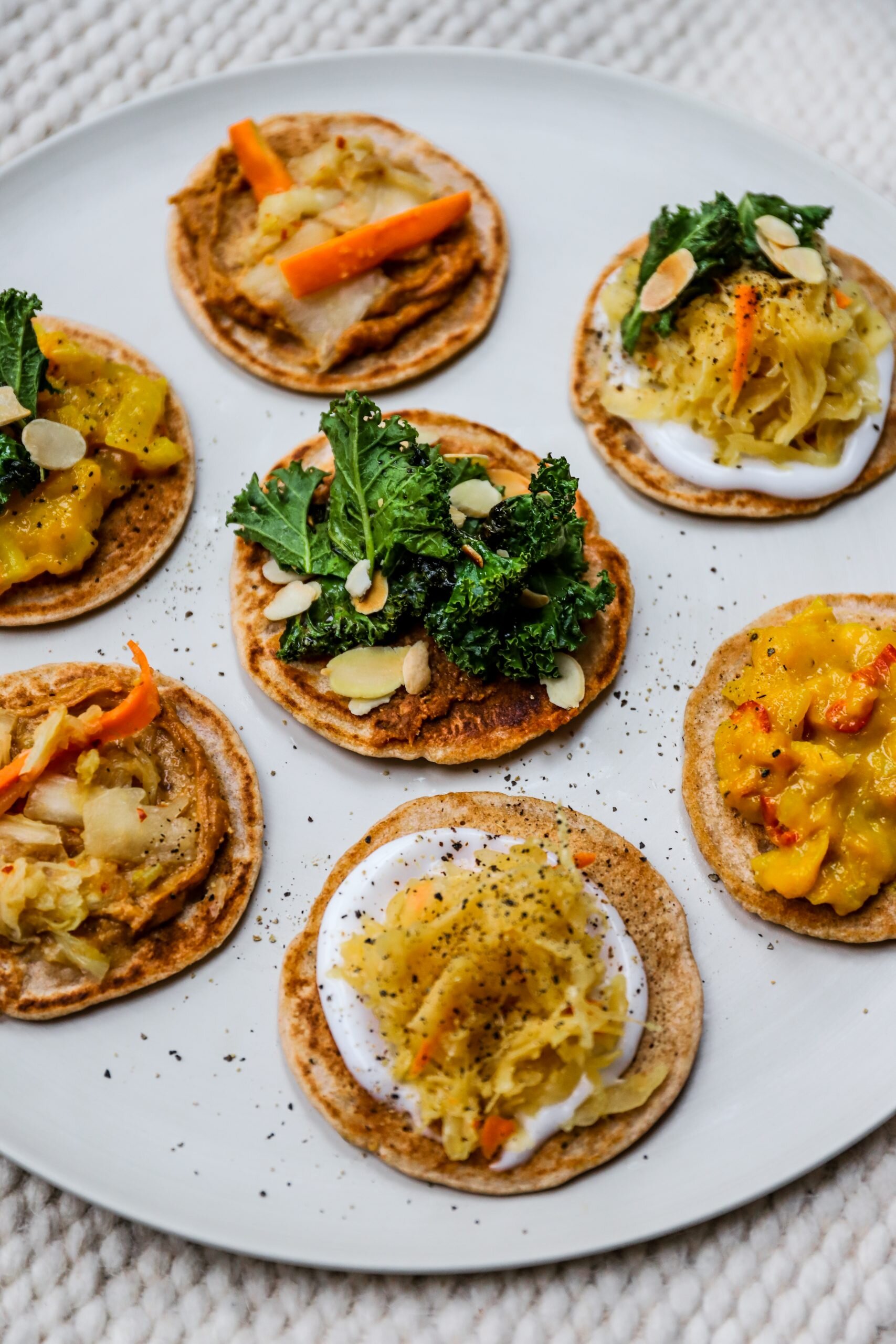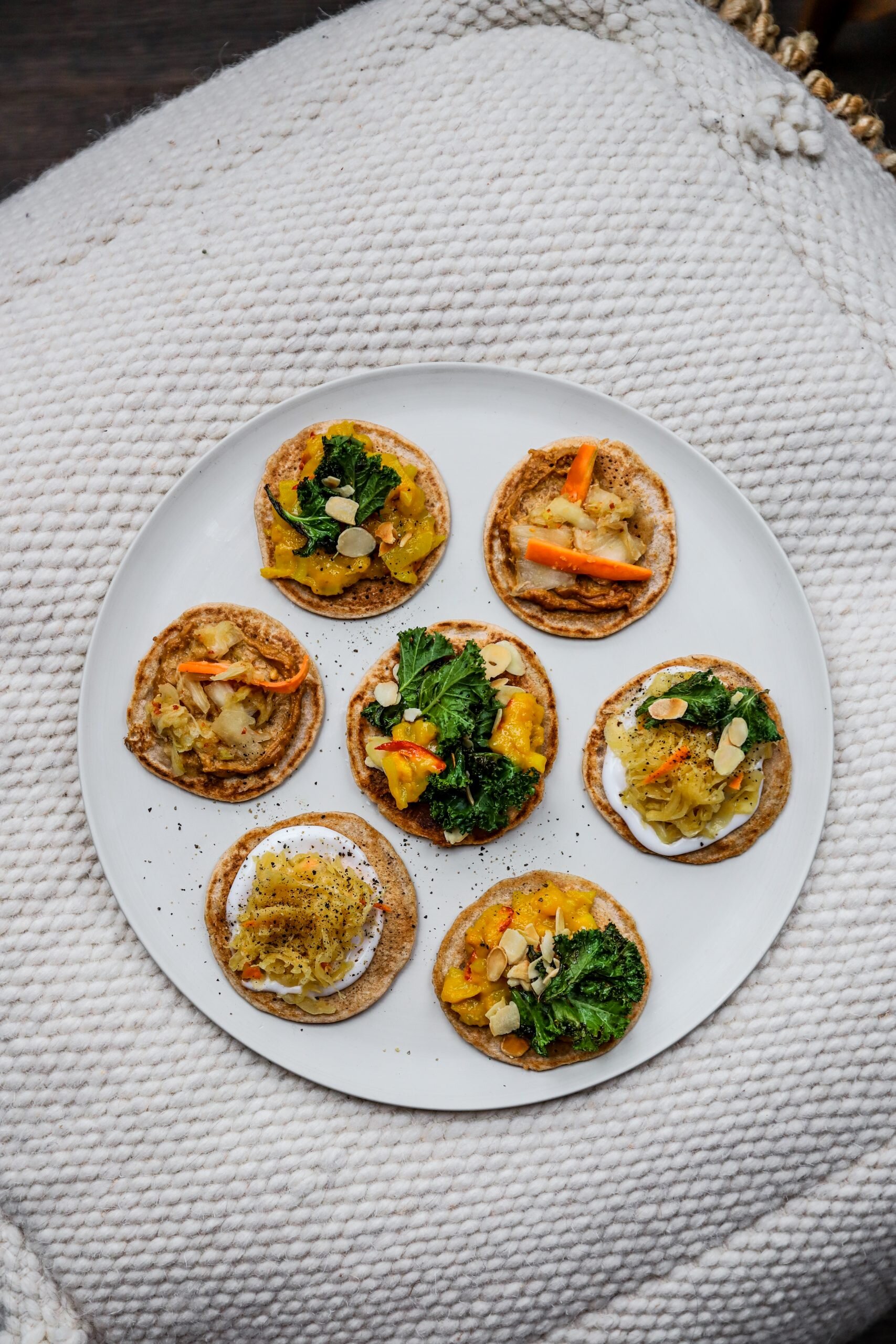Homemade Kimchi on Buckwheat Pancakes with Miso & Peanut Butter Spread
Get ready for this game changer
It may sound like an odd combination but trust me. This is the real deal. I do realise that this recipe is very multi-layered, but the combination is just so worth it. In case you feel like only making Kimchi today, go for it! Maybe you’ll hear the buckwheat pancakes & peanut-miso-butter calling in a few days though..
For the kimchi
Ingredients
1 head Chinese cabbage
1 tbsp sea salt
2 medium sized carrots, finely sliced or grated
4 spring onions, roughly chopped
2 tbsp tamari (you can also substitute with soy sauce)
2 tbsp date syrup
1/4 cup apple juice
1 apple
1 white onion
1 thumb-pieced chunk of ginger
2 cloves of garlic
2 tsp salt
1/2 cup Gochugaru (these are Korean Chili flakes – if you want use regular chili flakes, be aware that it may be spicier and not taste like traditional kimchi, but still delicious!)
1/4 cup lukewarm water
you will also need
mason jar, clean and rinsed with hot water before use
make sure that you wash your hands before being in contact with the ingredients. Despite basic hygienic measures, we all have naturally occurring bacteria on our hands some of which may even aid the fermentation process – so don’t be afraid, your kitchen doesn’t have to turn into a sanitised hospital room!
Instructions
1. Remove the outer leaves of the cabbage and rinse them well. We need them to seal our jar of kimchi later on!
2. Take the rest of your cabbage and slice it into bite-friendly chunks (we do not need it finely grated as we would with Sauerkraut!).
3. Place your cabbage chunks in a big bowl and generously sprinkle with salt – 1 tablespoon of salt per cabbage will be enough. Place a weight (such as a pot or a plate) on your salted cabbage and let it rest for at least 1 hour (2 hours are better – if you have enough time, you can even let the cabbage rest overnight).
4. In the meantime, prepare the marinade. Place all ingredients in a blender and mix until well combined.
5. Rinse the cabbage to remove the salt, then let it rest in a strainer to allow excess water to drain.
6. Transfer the cabbage back to the big bowl and add in the carrots, spring onions and your kimchi marinade. Mix well, then press into your mason jar so that it submerges in its own juice. If you find that there isn’t sufficient liquid to ensure that our kimchi is covered in liquid, add a few tbsp of salted water (2% salt solution). To create a natural seal and prevent oxygen from spoiling our beloved kimchi, stuff one of the outer cabbage leaves that we saved earlier on top of your kimchi. Another trick is to add a weight to your jar – such as a small plastic bag filled with water and tied with a knot so no liquid can escape. Simply add this weight onto the mason jar and gently press it down, thereby making sure that liquid shoots up the sides to keep our cabbage under wraps.
6. Remove the rubber band of your mason jar and close the lid. The gases formed throughout the fermentation process will now be able to escape the jar. Let the kimchi ferment for a minimum of 2-3 days at room temperature, then place in the fridge. If you’re in for a funkier, tangier and more intense flavour profile, let it ferment for longer! I let mine bubble for a week and loved the result. Once in the fridge, your kimchi will be good for a few months.
For the spread
Ingredients
3 tbsp peanut butter (I use unsweetened, slightly chunky peanut butter)
1 tbsp miso of choice (you can use red or white miso)
1 dash of toasted sesame oil, if you have it
1 tsp maple syrup, date syrup or honey
a few tbsp of water
Instructions
1. Combine all ingredients in a bowl and add one tablespoon of water at a time. Stir until you get a smooth, creamy, spreadable consistency.
for the pancakes
Ingredients
1 1/2 cups (215g) buckwheat flour
2 tsp baking powder
350 ml water
1 tbsp apple cider vinegar
1 tbsp olive oil
salt to taste
Instructions
1. Mix the dry ingredients, then add the wet ones. Stir until the dough comes together. Add a little oil to the pan and then fry the pancakes for 2-3 mins on each side.
2. Now let’s make this magic happen. Take a buckwheat pancake (or if you skipped that step, you can also use a slice of bread – I highly recommend toasted sourdough), generously spread some of the peanut butter & miso paste onto it and top it up with your fermented homemade kimchi. Bite into it and tell me that this isn’t incredibly delicious – I wouldn’t believe you!
Try combining these pancakes with different fermented products such as coconut yoghurt and sauerkraut, mango chutney or pan-fried crunchy kale served with that same miso & peanut butter goodness. Highly recommended.



